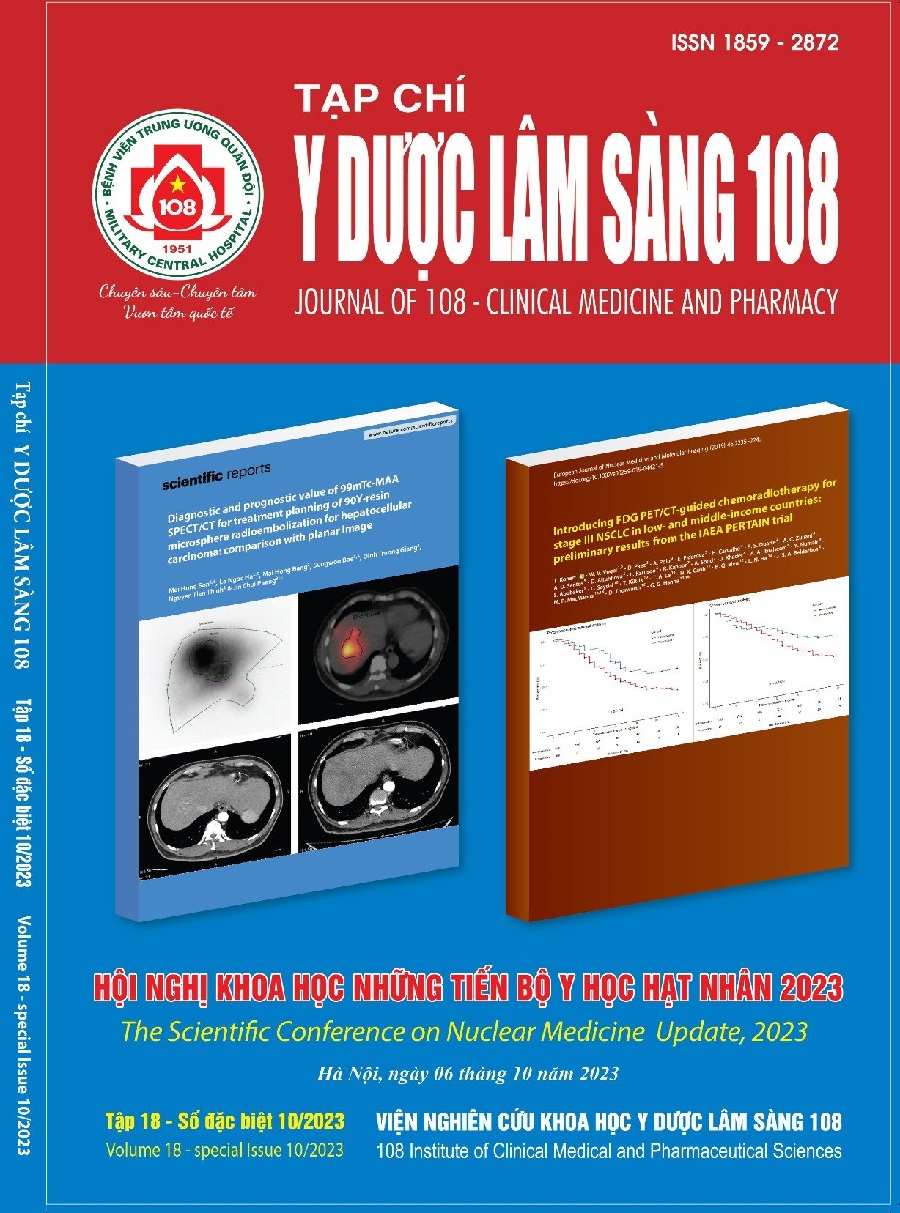Initial study of the column adsorption of radioactive iodine onto mixture of composite material ZSM-5/PVA and biochar/PVA
Main Article Content
Keywords
Abstract
Objective: This study focuses on the investigation of the 131I adsorption from aqueous solution using biochar/PVA and ZSM-5 zeolite/PVA composite material, resulting in determining the approriate ratio mass of biochar/ZSM-5 zeolite when treating real wastewater and indicating the reduction of the time storage of 131I radioactive waste water after the column adsorption. Subject and method: The adsorption column consist of biochar/PVA and ZSM-5 zeolite/PVA composite materials with the different rates of biochar/ZSM-5 zeolite. By using the column adsorption, fabricated composite materials have spherical granules with various rates of biochar/ZSM-5 zeolite mass (9:1, 8:2, 7:3, 6:4). After that, the aqueous solutions of radioactive 131I with the same initial concentration are slowly flowed through the column. The radioactivities of 131I before and after the uptake are determined to evaluate the column adsorption capacity after the iterations of 1, 2 or and 3 times. Result: The initia results show that the biochar:ZSM-5 zeolite mass ratio ranging from 6:4 to 9:1 has no significant difference in the ability to absorb 131I under the surveyed conditions. The adsorption efficiency of 131I by the filter column reached approximately 40% after 3 cycles. This result also shows thar after 3 cycles, the adsorption capacity of 131I has not shown signs of saturation. Conclusion: The mixture of biochar/PVA and ZSM-5 zeolite/PVA composite materials has the ability to treat radioactive iodine and shows potential for application in treating wastewater containing radioactive iodine in hospitals that treat thyroid cancer patients with radioactive drugs (131I).
Article Details
References
2. Abdmeziem K, Siffert B (1994) Synthesis of large crystals of ZSM-5 zeolite from a smectite-type clay material. Applied Clay Science 8(6): 437-447. doi: 10.1016/0169-1317(94)90038-8.
3. Tuấn PA, Len PT, Thống TV (2019) Tính toán hệ thống bể lưu chất thải lỏng phóng xạ tự động gồm nhiều bể nhỏ trong điều trị ung thư tuyến giáp bằng I-131. Trung tâm Y học Hạt nhân và Ung bướu, Bệnh viện Bạch Mai.
4. Kubota T, Fukutani S, Ohta T, Mahara Y (2013) Removal of radioactive cesium, strontium, and iodine from natural waters using bentonite, zeolite, and activated carbon. Journal of Radioanalytical and Nuclear Chemistry 296(2): 981-984. doi: 10.1007/s10967-012-2068-4.
5. Mu W, Yu Q, Li X, Wei H, Jian Y (2016) Adsorption of radioactive iodine on surfactant-modified sodium niobate. RSC advances 6(85): 81719-81725. doi: 10.1039/C6RA18091D.
6. Zheng B, Liu X, Hu J, Wang F, Hu X, Zhu Y, Lv X, Du J, Xiao D (2019) Construction of hydrophobic interface on natural biomaterials for higher efficient and reversible radioactive iodine adsorption in water. Journal of hazardous materials 368: 81-89. doi: 10.1016/j.jhazmat.2019.01.037.
7. Liu Y, Gu P, Jia L, Zhang G (1994) An investigation into the use of cuprous chloride for the removal of radioactive iodide from aqueous solutions. Journal of hazardous materials 302: 82-89. doi: 10.1016/j.jhazmat.2015.09.045.
8. Ochiai K-i, Fuseya Y (1994) Process for the separation of radioactive iodine compounds by precipitation. Google Patents.
9. Liu Y, Gu P, Yang Y, Jia L, Zhang M, Zhang G (2016) Removal of radioactive iodide from simulated liquid waste in an integrated precipitation reactor and membrane separator (PR-MS) system. Separation and Purification Technology 171: 221-228. doi: 10.1016/j.seppur.2016.07.034.
10. Rahman R, Ibrahium H, Hung Y-T (2011) Liquid radioactive wastes treatment: A review. Water 3(2): 551-565. doi: 10.3390/w3020551.
11. Sinha P, Lal K, Ahmed J (1997) Removal of radioiodine from liquid effluents. Waste Management 17(1): 33-37. doi: 10.1016/S0956-053X(97)00034-2.
12. Huve J, Ryzhikov A, Nouali H, Lalia V, Augé G, Daou TJ (2018) Porous sorbents for the capture of radioactive iodine compounds: A review. RSC Advances 8(51): 29248-29273. doi: 10.1039/C8RA04775H.
13. Reimerink WMTM (1999) The use of activated carbon as catalyst and catalyst carrier in industrial applications. Studies in Surface Science and Catalysis 120: 751-769.
14. Faghihian H, Ghannadi Maragheh M, Malekpour A (2022) Adsorption of radioactive iodide by natural zeolites. Journal of radioanalytical and nuclear chemistry 254(3): 545-550. doi: 10.1023/a:1021698207045.
15. Nguyen DK, Dinh VP, Dang NT, Khan DT, Hung NT, Thi Tran NH (2023) Effects of aging and hydrothermal treatment on the crystallization of ZSM-5 zeolite synthesis from bentonite. RSC Advances 13(30): 20565-20574. doi: 10.1039/D3RA02552G.
16. Dinh VP, Nguyen DK, Luu TT, Nguyen QH, Tuyen LA, Phong DD, Kiet HAT, Ho TH, Nguyen TTP, Xuan TD (2022) Adsorption of Pb(II) from aqueous solution by pomelo fruit peel-derived biochar. Materials Chemistry and Physics 285: 126105. doi: 10.1016/j.matchemphys.2022.126105.
 ISSN: 1859 - 2872
ISSN: 1859 - 2872
